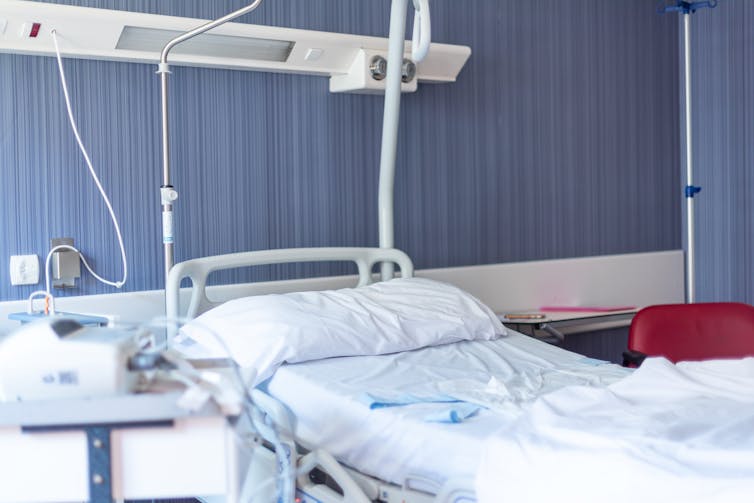
Toowong Private Hospital in Brisbane is the latest hospital to succumb to financial pressures and will close its doors next week. The industry association attributes the psychiatric hospital’s closure to insufficient payments from and delayed funding negotiations with private insurers.
Meanwhile, the future of Australia’s second-largest hospital provider, Healthscope, remains uncertain, after its parent company went into receivership last week.
Healthscope’s 37 private hospitals are being kept afloat with a A$100 million loan and will continue to operate for now. But the hospitals will be sold to repay lenders, so their future depends on who buys and what the new owners decide to do.
Across the board, private hospitals are struggling with soaring costs for staff and supplies, while private health insurance isn’t paying enough to cover these expenses.
These underlying issues will not disappear magically. More private hospitals will face similar financial troubles and some will be forced to close. But we’re unlikely to see the collapse of the entire private sector.
A mix of public and private
Australia operates a unique public-private health-care mix, with around 700 public and 647 private hospitals.
Public hospitals are largely government-owned and provide free care, funded by taxes. Private hospitals are owned and managed by private organisations, some of which are non-profit.
The private health-care sector plays a large role in Australia, providing 41% of all hospitalisations, however 74% are same-day stays.
Private hospitals are often smaller than public hospitals, without emergency departments, focusing on simpler, same-day care, and are more likely in cities. Some 83% of private hospitals are in metropolitan, 9% in regional centres and 8% in rural towns.
In contrast, 27% of public hospitals are in the major cities, 57% in regional areas and 16% in remote areas.
The role of private health insurance
Most people who access private hospitals have private health insurance or are covered by another system such as Veterans Affairs – otherwise private hospital care is too expensive and few can afford it.
In 2022-23, the total A$21.5 billion was spent on private hospitals. Private health insurance covered about 45% ($9.7 billion), which comes from members’ premiums. Patients contributed 11% ($2.4 billion) in out-of-pocket costs.
The government contributed a substantial 37% ($8 billion) mainly through Medicare. This is separate from the additional $8 billion the government provides annually as rebates to individuals for buying private health insurance.

A key issue is this rebate money doesn’t directly flow to private hospitals, leaving them vulnerable in negotiations with insurers, as we saw with Toowong Private Hospital.
Evidence suggests these rebates might not be the most effective government investment. Experts, including me, have argued for direct funding into hospitals instead.
So, as more private hospitals face troubles, what does this mean?
Less choice and access for patients
Patients will experience less choice and potentially harder access for specific types of care.
In larger metropolitan areas with numerous private and public hospitals (including private wings in public hospitals), patients might switch to other private facilities or seek care as private patients in public hospitals.
However, in smaller or rural areas with limited or no other private hospitals, choice diminishes significantly. In this case, you will need to reconsider whether you need to buy private health insurance.
Currently, people earning over $97,000 (or families over $194,000 face an additional Medicare Levy Surcharge if they don’t hold private health insurance.
This policy is not fair to those who have no access to private hospitals and should be changed.
Read more: Who really benefits from private health insurance rebates? Not people who need cover the most
While there might be slightly longer waits in the short-term for elective surgeries due to shifting patient loads, our analysis suggests this won’t be a major long-term problem. The primary constraint for wait times is often personnel, not facilities.
If private hospitals close, doctors and nurses could potentially shift to public hospitals, helping to alleviate staffing shortages and reduce overall wait times.
Impacts for the public system
The impact on public emergency departments will be minimal, as most private hospitals lack them.
Many private hospital admissions are same-day and for simpler procedures. So public hospitals and remaining private hospitals (that are not operating at full bed capacity) should be able to absorb this extra demand in the long run, if they can attract more staff previously employed (or even facilities) in the closing private hospitals.
These hospitals will also receive additional revenue for these additional procedures.

Consequently, the effect on public hospital wait times for most conditions should not be substantial.
However, some complex, long-stay, or specific mental health cases (such as those from Toowong) may be hard to absorb without additional supply of specialists and funding.
What about health budgets?
In areas where patients are absorbed into existing public hospital capacity or other private facilities, the direct impact on the health budget would be minimal.
With more patients, the remaining private hospitals may gain more power to negotiate better funding contracts with insurance companies and achieve better supplier costs through economies of scale.
In areas where private hospitals (or public hospitals offering private care) cease to be viable, and people drop their private health insurance cover to use public hospitals, the government would pay more directly into public hospitals. However, this increased cost would be partially offset by reduced expenditure on private health insurance rebates.
Patients would also save money on premiums and out-of-pocket costs in private hospitals, though they would lose the choice of private care.
Ultimately, where a private model isn’t financially sustainable, the government or taxpayers often end up bearing the cost anyway.
Investing more directly in public hospitals in these areas, rather than relying on inefficient rebates, could be a more effective solution.
Correction: an earlier version of this article said access to private hospitals requires private health insurance.
Read more: Does private health insurance cut public hospital waiting lists? We found it barely makes a dent
Yuting Zhang has received funding from the Australian Research Council (future fellowship project ID FT200100630), Department of Veterans' Affairs, the Victorian Department of Health, National Health and Medical Research Council and Eastern Melbourne Primary Health Network. In the past, Professor Zhang has received funding from several US institutes including the US National Institutes of Health, Commonwealth fund, Agency for Healthcare Research and Quality, and Robert Wood Johnson Foundation. She has not received funding from for-profit industry including the private health insurance industry.
This article was originally published on The Conversation. Read the original article.







